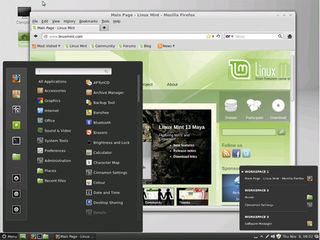How Mint became one of the most popular Linux distros
We speak to the creator of Mint, Clem Lefebvre
One distro, two desktops

The birth of Cinnamon and Mate
Linux Mint 13 was the first Mint release that didn't have Gnome as a standard environment; it gave users the choice of versions based on Mate and Cinnamon.
Mate has rapidly become the users' favoured choice, and is perceived as being the true successor to Gnome 2; the fact that it is a direct fork of Gnome 2 helps, but in the eyes of users who consider Gnome 2 as the last great desktop environment, Mate offers a sensible return to function and order.
Introduced in Mint 12, Mate was fast and responsive, and combined with Mint's serene colour schemes, themes, fonts and window decorations, the user got a working desktop that didn't require the re-learning of how to search for simple applications. Mate may not be that popular at the moment, but given time we could see the pendulum swing in favour of functionality.
As Clem says: "Mate 'is' the new Gnome 2. Whichever way you look at it, Gnome 2 was 'renamed' and its new name is Mate. There is no other project as active as Mate, which continues where Gnome 2 left off. With version 1.4, Mate goes beyond Gnome 2; it fixes bugs which were in Gnome for years and adds new features."
The other Mint desktop, Cinnamon, is the replacement for Gnome 3, and the spiritual successor to MGSE (Mint Gnome Shell Extensions). With Gnome Shell going in a direction that offended the majority of the community, a compromise was needed. Consequently, the direction of Gnome was something that weighed heavily on the development of Mint, therefore the forking and creation of the Cinnamon project brought about a better-developed and more acceptable desktop environment.
"Cinnamon is primarily developed by and for Linux Mint," says Clem. "We make sure that it works with all distributions, but it is the implementation of our own vision of the desktop. In Cinnamon 1.6, this vision extends to file management and desktop handling with the addition of Nemo."
Get daily insight, inspiration and deals in your inbox
Get the hottest deals available in your inbox plus news, reviews, opinion, analysis and more from the TechRadar team.
Cinnamon on toast
Cinnamon started with a fork of the Gnome 3.2.1 shell, and included the previously designed features from MGSE. It was designed to be innovative and fresh, and to appeal to most Linux users. Cinnamon held its arms open to those who weren't convinced with the new, and still believed that the traditional desktop had considerable life left in it.
As the Cinnamon slogan states: "Love your Linux, feel at home, get things done!". Clearly a slogan that reflects the radical changes that have taken place over the last few years, with many users stating that it feels more like using Gnome 2.x, but with a more modern approach. Users could now shut down and restart their computers without the headache-inducing shenanigans of Gnome 3; and they could benefit from the latest goodies that Gnome 3 included.
Cinnamon also included a return to customising the desktop, something which is possible with the likes of Gnome 3, but isn't quite as forthcoming as one would have liked. Being able to move the menu bar around the screen, fiddling with the desktop effects, adding themes, applets and extensions was a breeze; customisation was back on the menu, and the users savoured it.
As with Mate, though, there were niggles that cropped up from one user to another; but it's still very young, and rather than creating a Frankenstein environment, cobbled from the body parts of Gnome 3 or Unity, Cinnamon represented a brave new world.
"I don't think either desktop will rule supreme", says Clem. "Cinnamon certainly has a lot of fans, but so does Mate. We love both. Mate is the continuation of what Mint was built on. It's the desktop we used to enhance the user experience year after year, it's what mintMenu, mintDesktop were designed for. There's nothing more mature than Mate, and it's extremely important to us. Cinnamon, on the other hand, is our own implementation of the desktop, so any idea, any concept can be implemented there and on top of brand new and exciting technology."
